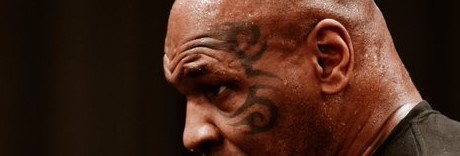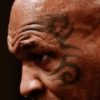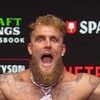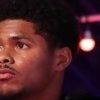September 13, 1981…John McEnroe was on top of the world. He was the world’s #1 tennis player, having just won his third consecutive U.S. Open title in New York. Just three nights after his 46 62 64 63 KO win over Bjorn Borg, which sent the super Swede staggering into retirement at age 25, McEnroe would witness another sensational sporting event which was staged in an arena erected on the tennis courts of Caesars Palace in Las Vegas.
“I went to the Sugar Ray Leonard-Thomas Hearns fight, the first one. And I had like these incredible seats,” recalls McEnroe. “My late, great friend Vitas Gerulaitis had set it up. We were in Vegas for a tournament. They put me in the first row, next to the Governor of Nevada and Larry Holmes (then the dominant WBC Heavyweight champ with 10 successful title defenses).”
“The Showdown” as it was billed, had a profound effect on almost everyone who saw it, especially those sitting in the first row. “The intensity that I experienced just watching it – you could sense how some people were afraid and the emotion of what was going on, because I was so close the energy was so electric that, like, I was sort of wishing and hoping that tennis could even get close to that, in terms of the electricity that was there,” says the man who won three Wimbledon titles (81, 83, 84) and four U.S. Opens (79, 80, 81, 84). “But it was almost like you were almost – I felt almost afraid if one of the people – you’re so close – like Hearns was trying to hit Leonard – I thought he was gonna just knock him into smithereens or something. And how amazing it was to feel what was going on – I think that cemented my love of it.”
It was McEnroe’s first time attending a live boxing match. “To go to that as the first one was unbelievably nerve-racking in a way but it was really exciting. So that definitely made me want to go to a lot more. I haven’t been to as many as I’d like just because of my own schedule. I’ve been at a fair amount of fights at Madison Square Garden and in New York, but I could go to fights regularly, that would be a good way for me to spend a night. I hope that it still continues to happen in the future. The ones that I have been at, for the most part, have been tremendous.”
Before turning pro McEnroe spent one year at Stanford University in California and has a boxing memory from there. “I was taking an astronomy course, somehow I remember watching Ali-Spinks I in the astronomy at the huge dome that they have in Stanford. I remember being very depressed seeing Ali lose and he looked old and he just couldn’t do anything and then I thought, At least I was young. Now when I think about it, well, at least in tennis you don’t have to physically feel like you’re risking your life. You get laid out to bare, like, Okay, the guy’s over the hill, he should throw in the towel. People are always quick to say that but I’m glad I picked the safer sport.”
Now 50, McEnroe works as a TV analyst for major tournaments, acts in small roles in film, TV and commercials, and still competes in exhibitions and the senior tennis tour, posting recent wins over Pete Sampras and Jim Courier. A few years ago when I last spoke with McEnroe, he credited another former heavyweight champion as a motivating influence. “When I looked at George Foreman and what he did in boxing, that always inspired me to dig a little deeper and train harder.”
The tennis warrior who once won a six-hour, 22-minute epic Davis Cup five-setter against Mats Wilander, says the current state of boxing is somewhat in the same boat as tennis. “I follow boxing pretty much, but not as close as I used to. It seems like it’s close to tennis in that some of the personality – it seems to have lost some of that. And there’s other people taking away some of their market, whether it’s the Ultimate Fighters, just other sports in general. It reminds me that you have to continue to really promote and reach out. Like something we’re trying to do today (McEnroe hit balls with Billie Jean King on a court built on a floating barge on the Hudson River, to help hype the USTA’s “May Is Tennis Month.”)
“It could be ebbs and flows but nonetheless it seems like there’s not a lot going on, unless I’m missing something. It’s actually quite similar to tennis in the sense that one of the reasons why the heavyweights have sort of – you don’t hear much about it – it’s not only because of this situation when they talk about, Well who could match Ali’s personality? How ferocious Tyson was when he was young. But a lot of these guys are foreigners now. And in tennis we have the same issue. Americans have to get their act together. To have all these Russians and Eastern Europeans at the top – would have been unheard of 20-30 years ago.”
Speaking of Tyson, McEnroe, the former tennis bad boy, remembers the first time he personally met The Baddest Man On The Planet: “The first time I ever met him he went like this – and he grabbed me by the chest. But he was like checking to see if I had any muscles. And I go, Tennis players don’t have any muscles there, we don’t need muscles there. We just need, like, big legs, were not supposed to have chest muscles. I kind of made an excuse for it,” he says with a smile. “Because he was checking to see how strong I was.” McEnroe also adds another first impression about Tyson – “he seemed very smart.”
Though not a physically explosive player like Federer and Nadal today, McEnroe reigned as the world’s best player from 1981-1984 with an instinctive game characterized by quick reflexes and a feathery touch which could create the most unexpected sharply angled volleys and winners. When asked which boxers remind him of himself, the 5-ft-11, 165-pound McEnroe pauses, then humbly replies, “I don’t think I could really. I would like to say a guy like Barry McGuigan, being Irish, with the huge crowd support.” And after another thoughtful pause, he offers another unexpected choice. “Hagler.” Whoa, he cannot be serious. Marvin Hagler? “Because he was lefty. Later in my career I thought that I needed to change something. There was a lot more power coming into the game. (I thought) I’ve gotta do something to get stronger, whatever. But ultimately you can’t change what you do best. And remember when Hagler fought Leonard, he came out righty? And you were like, What is he doing? Right? And then he was probably trying to out-think him, that he could do that. But in truth, if he had just stayed with what like got him there, he probably would have intimidated him a lot more. And it reminded me of the end, where I started second-guessing myself. And you start thinking, Should I serve harder, even if it’s less precise? I’ve gotta get stronger so I could hit harder.”








